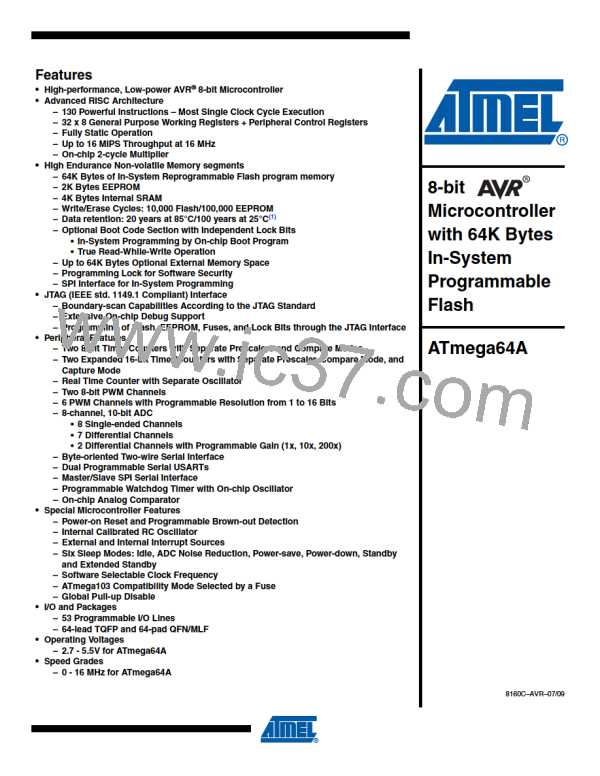ATmega64A
It is the user software’s responsibility to ensure that these illegal arbitration conditions never
occur. This implies that in multi-master systems, all data transfers must use the same composi-
tion of SLA+R/W and data packets. In other words: All transmissions must contain the same
number of data packets, otherwise the result of the arbitration is undefined.
21.6 Using the TWI
The AVR TWI is byte-oriented and interrupt based. Interrupts are issued after all bus events, like
reception of a byte or transmission of a START condition. Because the TWI is interrupt-based,
the application software is free to carry on other operations during a TWI byte transfer. Note that
the TWI Interrupt Enable (TWIE) bit in TWCR together with the Global Interrupt Enable bit in
SREG allow the application to decide whether or not assertion of the TWINT flag should gener-
ate an interrupt request. If the TWIE bit is cleared, the application must poll the TWINT flag in
order to detect actions on the TWI bus.
When the TWINT flag is asserted, the TWI has finished an operation and awaits application
response. In this case, the TWI Status Register (TWSR) contains a value indicating the current
state of the TWI bus. The application software can then decide how the TWI should behave in
the next TWI bus cycle by manipulating the TWCR and TWDR registers.
Figure 21-10 is a simple example of how the application can interface to the TWI hardware. In
this example, a Master wishes to transmit a single data byte to a Slave. This description is quite
abstract, a more detailed explanation follows later in this section. A simple code example imple-
menting the desired behavior is also presented.
Figure 21-10. Interfacing the Application to the TWI in a Typical Transmission
1. Application writes
to TWCR to initiate
transmission of
START
3. Check TWSR to see if START was
sent. Application loads SLA+W into
TWDR, and loads appropriate control
signals into TWCR, making sure that
TWINT is written to one, and
5. Check TWSR to see if SLA+W was
sent and ACK received.
Application loads data into TWDR,
and loads appropriate control signals
into TWCR, making sure that
TWINT is written to one
7. Check TWSR to see if data was sent
and ACK received. Application loads
appropriate control signals to send
STOP into TWCR, making sure that
TWINT is written to one
TWSTA is written to zero.
TWI bus
START
SLA+W
A
Data
A
STOP
Indicates
TWINT set
4. TWINT set.
2. TWINT set.
Status code indicates
START condition sent
6. TWINT set.
Status code indicates
data sent, ACK received
Status code indicates
SLA+W sent, ACK
received
1. The first step in a TWI transmission is to transmit a START condition. This is done by
writing a specific value into TWCR, instructing the TWI hardware to transmit a START
condition. Which value to write is described later on. However, it is important that the
TWINT bit is set in the value written. Writing a one to TWINT clears the flag. The TWI will
209
8160C–AVR–07/09

 ATMEL [ ATMEL ]
ATMEL [ ATMEL ]